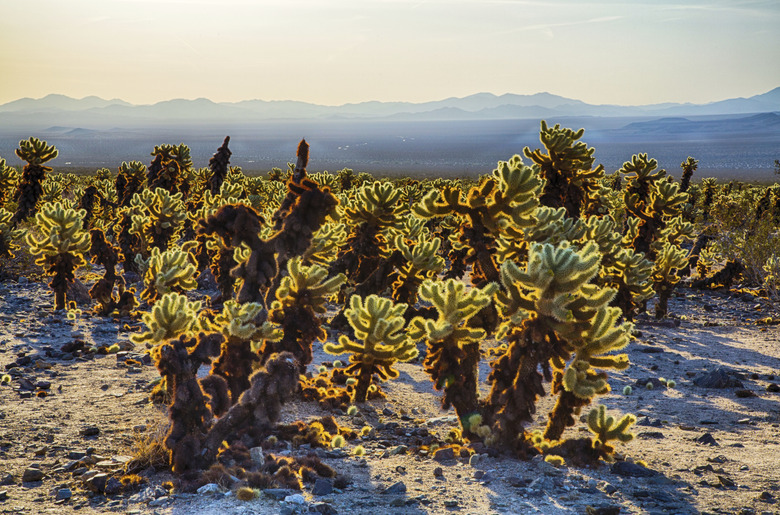What Are The Dangers Of A Jumping Cholla Cactus?
The jumping cholla cactus (Opuntia fulgida) gets its name from spiny segments that detach so easily they seem to attack anyone near them. This plant can go beyond painful contact in a garden or on a hiking trail and become an aggressive menace. The jumping cholla grows in U.S. Department of Agriculture plant hardiness zones zones 8b through 11.
Jumping Cactus Basics
The jumping cholla grows 8 to 10 feet tall in a tree shape and produces fuschia-colored blossoms in spring. It's also called chain fruit cholla, boxing glove cholla, velas de coyote, cholla brincadora and hanging chain cholla. This drought-tolerant cactus attracts birds, bees and butterflies. In addition to adding an authentic rustic desert texture and color to a yard, the spiny jumping cholla provides a formidable barrier, such as to deter a potential burglar from approaching an upstairs window. Yet the protective features of the jumping cholla mean you must take care to avoid accidental injury.
- The jumping cholla cactus (Opuntia fulgida) gets its name from spiny segments that detach so easily they seem to attack anyone near them.
The Better to Spike You With
Natural health advocate Dr. Andrew Weil describes the jumping cholla as the most dangerous cactus where he lives near Tucson, Arizona. The jumping cholla is covered with sharp spines and masses of fine, irritating barbs, called glochids. When the spines touch skin or clothing, the segment comes off the plant. If a "boxing glove" from a cholla attaches to you, its large and fine spikes get into your skin. The reverse barbs make them difficult to remove.
Spiny Projectiles and Glochids
Attempting to shake a jumping cholla segment off could cause it to hit your face, another person or a pet. Use a large comb or sticks to remove it. A strong wind may cause segments to fly and hit anyone nearby. A reflex to suck the painful glochids out of the skin can cause them to embed in the soft tissues of the mouth, tongue, throat and windpipe, and may be fatal, advises KCET.
- Natural health advocate Dr. Andrew Weil describes the jumping cholla as the most dangerous cactus where he lives near Tucson, Arizona.
- A reflex to suck the painful glochids out of the skin can cause them to embed in the soft tissues of the mouth, tongue, throat and windpipe, and may be fatal, advises KCET.
The Spiky Takeover
Mesa, Arizona has a record of a massive growths of jumping cholla overrunning sidewalks, bus stops and cul de sacs, putting passersby, playing children and pets in danger. The city had to remove the menacing cactuses. Protect yourself if you have to handle this type of cactus. Wear reinforced work gloves, safety goggles, a hat, and heavy-duty, long-sleeve shirt and pants when you plant, transplant, take cuttings, harvest seeds or remove an invasive jumping cholla. If you need to handle it, do so with metal implements, such as barbecue tongs, whenever possible.
